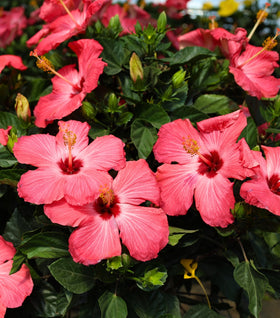Images Depict Mature Plants
Paradise Hibiscus Plants for Sale Online
Paradise Hibiscus are flowering perennials that are best known for their stunning ombre blooms that can grow up to 8 inches across. The huge flowers of this tropical Hibiscus have ruffled, overlapping petals and an airbrush color effect. Paradise Hibiscus is a compact perennial plant that does well in containers on sunny patios, porches, or decks. It flowers over a longer period of time than other Hibiscus cultivars so you can enjoy the blooms all summer long.
The ruffled petals fade to a different color along their edge and if you buy your Paradise Hibiscus online, the color of the bloom will be a surprise! We have varieties that are red in the center, fading into light pink and yellow but also flowers that have a periwinkle and orange fade; both are equally beautiful!
An especially compact variety, this forms a medium-sized bushy mound of dark green leaves. Huge saucer-shaped flowers appear in mid-summer and continue until frost. Plants prefer evenly moist soil and sunny conditions. Stems die back completely to the ground in winter, but new growth is slow to appear in spring, so be patient! Old stems can be pruned to the ground in mid-spring. A thick mulch for the first winter is recommended, especially in Zones 4 and 5.
| Hardiness Zone: | 5-10 |
|---|---|
| Mature Height: | 3 to 4 Feet |
| Mature Width: | 4 to 5 Feet |
| Classification: | Perennial |
| Sunlight: | Full sun |
| Habit: | Upright, compact |
| Flower Color: | Airbrush |
| Flowering Season: | July to September |
| Foliage: | Green |
| Soil Condition: | Prefers evenly moist soil |
| Water Requirement: | Water well until established |
| Uses: | Extremely attractive when used as a focal point in the mixed perennial border, mass planting |

How to Care for Paradise Hibiscus Plants
Be sure to read our planting instructions to ensure a healthy and happy plant for years to come!

What type of mulch should I be using for a Paradise Hibiscus?
We highly recommend that you mulch your Paradise Hibiscus with either a ground hardwood mulch or a ground cypress mulch depending on your local availability. Any type of mulch will do but cypress or hardwood mulch will be of a higher quality and provide better nutrition overall as they breakdown. Mulching helps to keep weeds away which will compete with your new investment for water and nutrients. A 2 to 3 inch layer of mulch is sufficient but remember to take care not to cover any part of the stem of the plant with mulch. It's better to leave a one inch gap of space between the mulch and the stem or base of the plant.
What kind of fertilizer should I be using for Paradise Hibiscus?
Feeding your plants is probably the single most forgotten part of growing healthy long lasting plants. We recommend feeding your Paradise Hibiscus in the very early spring and again in mid summer after all new growth has hardened off and it begins to set flower buds. Bio-tone starter fertilizer is the best product to use at the time of planting. Our ideal fertilizer schedule for you to use is as follows. Apply an early spring fertilizer with a product such as Espoma Flower-tone at the recommended rate this will give the plant a boost of nitrogen potash that will be needed for healthy foliage and stem growth. Follow this up with another early summer application of Espoma Flower-Tone, this will again provide the necessary nutrients to promote a flush of beautiful flowers. Espoma products are easy to use, just sprinkle around the base of the plant and water it in. Be careful with products such as miracle-grow as these products can burn newly planted plants when not used at the recommended rates. Slow-release fertilizer can help prevent rapid soft growth that is vulnerable to diseases and insects.
-v1591110493424.png?89x89)
When should I prune my Paradise Hibiscus?
Remove the old flowers of Paradise Hibiscus as they become brown and unattractive including the seed pods. This procedure, called deadheading, encourages the Paradise Hibiscus plant to produce new flowers, keeping your plant looking attractive throughout the season. Deadheading also prevents Paradise Hibiscus from spreading through your yard, as it can be an effective self-seeder when the dead flowers are allowed to dry completely and go to seed this would cause problems for your garden. Remove the brown stems and leaves to give your plant a healthier and more attractive appearance. Cut back Paradise Hibiscus to within 6 inches of the ground after it has finished flowering. In colder climates, cut it back as one of the last chores in your garden before the snow flies. In warmer climates, cut it back in the spring before it begins to bud. Cutting back will promote new growth, giving you a healthier plant with stronger stems. When to Prune Paradise Hibiscus: Hibiscus reliably blooms on the seasons new growth, so prune to the ground during late winter or very early spring before growth starts. Fall pruning, especially in colder climates, can result in a quick flush of new growth that prevents dormancy and makes winter freezes potentially deadly.








